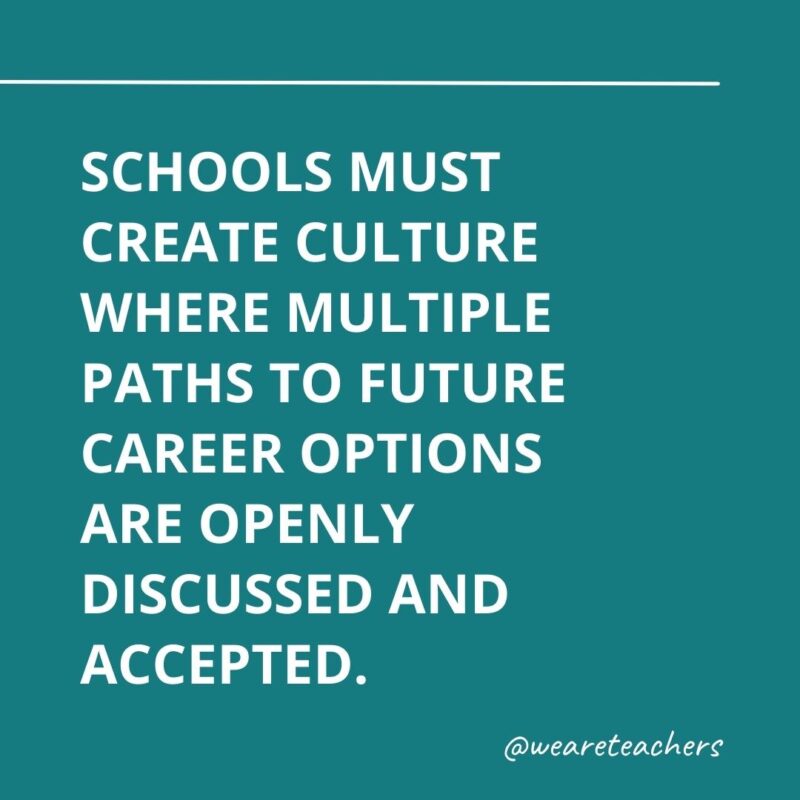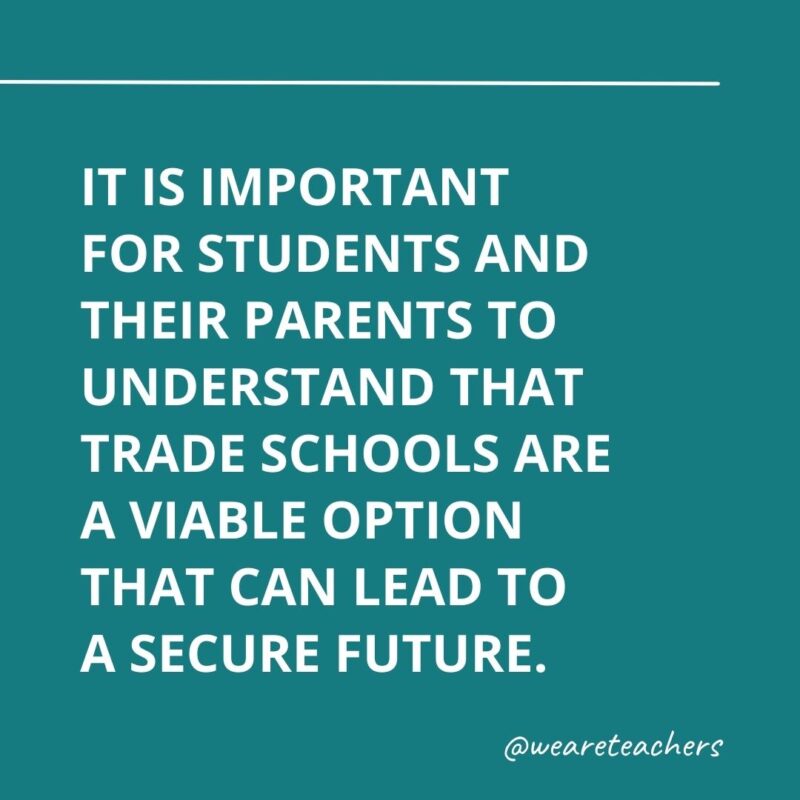When students and families think about post–high school education, trade schools are not often considered a viable option. Why? Well, there’s a stigma attached to them. Many understand trade school as an option for students who don’t do well (i.e., get good grades) in school. And many people think attending trade school won’t lead to a successful career. Traditionally, vocational training has been seen as a route for students who were not capable of attending a four-year college.
The reality? Trade schools are a practical, affordable, career-focused option for many graduating high schoolers. Vocational training should be regarded as the tremendously valuable option it is, not as the contingency plan for students who aren’t “college material.” In reality, trade schools can arguably offer many students a far more successful career than if they’d been forced into a one-size-fits-all four-year college plan.
As educators, we have a responsibility to educate our students on vocational training and end the stigma of trade schools. Here’s how we do that.
Being saddled with student loan debt is an increasingly unattractive option for many young people. The good news: The United States has 30 million jobs that pay $55,000 or more per year and do not require a bachelor’s degree. Experienced, well-trained supervisors and electricians often earn well into the six figures. People with trade school training are slightly more likely to be employed than those with academic credentials and significantly more likely to be working in their field of study, reports the U.S. Department of Education. This positive career outlook comes at a fraction of the cost that others pay for a college education. On average, a four-year college degree costs $127,000, while a trade school degree averages $33,000, a savings of $94,000.
Job prospects for those with trade school training are high, as there are not enough workers to fill available positions. And many tradespeople are nearing the age of retirement. This will open even more positions for newly trained tradespeople.
Trade school careers are a smart choice for students who want to work with their hands and learn through experience. Trade schools offer both online and in-person classes, allowing access for students who need a flexible schedule. The career opportunities offered through trade school are vast and include construction, carpentry, commercial diving, health care, electronics, forestry, plumbing, wind engineering, auto-body repair, and cosmetology.
Reflect the value of vocational training in your school culture

High schools often put a lot of emphasis on AP tests, honors classes, and college admissions. This practice, however, may unintentionally signal that students must enroll in these classes in order to be successful after graduation. Similarly, when students meet with guidance counselors, the focus is typically on completing college-entrance exams and essays. Counselors generally mention trade school only when they assume a student won’t be successful at a traditional college.
But trade positions require many of the same skills as careers offered through traditional four-year colleges. Math and science are often highly beneficial, along with close reading, creativity, and problem-solving. Students in trade school should be encouraged to take AP and honors classes just as much as students looking at a four-year college plan.
Create a school culture where multiple paths to future careers are openly discussed and accepted. It will take some getting used to, but changing the narrative requires all adults in a school being on board. Present honest information about trade school–career prospects to all students. Encourage teachers, administrators, and guidance counselors to choose their words carefully when discussing post–high school options with students. Ultimately, trade schools become a fallback option when college is presented as the optimal choice. Ask your staff to delve deeply into students’ long-term career interests before recommending post-secondary options.
Rethink college nights and career events

It’s essential to create opportunities for students to learn about career options offered through vocational training. It’s also important for students and parents to understand that trade schools can lead to future financial security. To educate them, consider your current college information night. Rather than focusing solely on college information, include all routes of post–high school education in the presentations. During these sessions, provide information about local trade schools as well as nationally known trade schools, focusing on a variety of careers. Highlight the advantages of these schools, such as lower costs, a quicker route to a career, and a high rate of job placement and security.
Coordinate field trips to trade schools and visits from professionals
Students should also have exposure to the trade school environment as well as professionals working in fields that hire trade school graduates. Most local trade schools welcome school field trips as a way to expose students to the type of education that takes place in this environment. It’s important that all students have the opportunity to experience these field trips. Your school can also invite professionals who are currently working in a trade to come in and speak to students. This allows students to ask questions and gain a better understanding of the life and career of a person in the trade field.
It’s time to remove the stigma once and for all. Attending college is not the only route to success. Trade school is not a second-rate alternative for kids who just can’t cut it. Trade schools, and the vocations they train students for, require intelligence and skill. They help students hone their abilities, leading them to secure and satisfying careers. We should encourage students to consider post-secondary options and pursue the paths that work best for their future plans, including attending trade school.


















